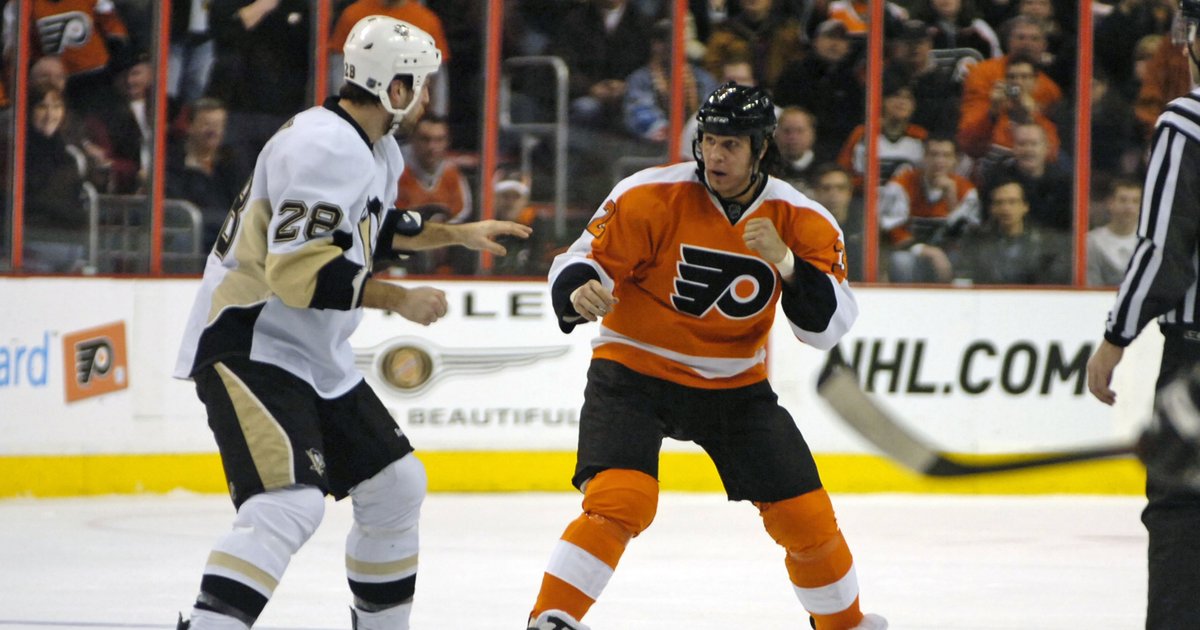Roughing it up as a hockey enforcer takes a toll, both physically and mentally. Riley Cote knows this and it’s shaped his post-NHL life as an advocate for the therapeutic value of cannabis.
Cote, who has partnered with the cannabis dispensary Trulieve, spent four years with the Flyers before retiring from the NHL following the 2010 season. It was the bruising work on the ice, fighting other players and a tiresome recovery process that led Cote to use cannabis for pain management.
RELATED: Pa. bill to legalize marijuana at state-run stores nixed by Senate panel before full vote
“Going back to my playing days, I was a cannabis user,” Cote, 43, said. “I didn’t understand the true therapeutic value, the medicinal value of the plant. I knew that it was helping me. It was certainly helping me relax and manage some performance anxiety and sleep.
“I was an enforcer. I was a hockey fighter. You can imagine, sports performance anxiety is high enough as it is, and then you’re worried about fighting the biggest, baddest dudes in the league. It cranks up the anxiety level to a whole different dimension. Cannabis was super helpful, but I didn’t have the language or the real information, the science to support the way I was feeling.”
Attitudes toward cannabis, that plant from which marijuana is derived, have shifted considerably in the last two decades – both in American culture and on professional sports landscape. Thirty-nine states, including Pennsylvania and New Jersey, now have medical marijuana programs. Twenty-four states, including New Jersey, have legalized recreational marijuana. The vast majority of Americans – 88% — say marijuana should at least be legalized for medicinal purposes, according to a 2024 Pew Research Center report.
That change has taken course in the NHL, too. Earlier this year, The Athletic interviewed more than three dozen NHL players about cannabis use, with 38% saying they use edible marijuana during the season. Most marijuana users said they preferred edibles with lower amounts of THC — the psychoactive chemical in marijuana — and higher amounts of CBD, an anti-inflammatory compound that provides relaxing effects without a high.
The report cites this more widespread use of cannabis as a factor in the decline of the alcohol-fueled partying that once was more common among the league’s players. The NHL does not prohibit players from using cannabis, but league and its players union refers players with concerning levels to the Players Assistance Program.
“It’s gotten a lot more socially acceptable across the board in sports. It’s night and day, honestly, from back when I played,” Cote said. “Not to date myself, because it wasn’t that long ago, but it was long enough ago that it wasn’t accepted and we did have to hide our cannabis use. And there were probably other guys that I wasn’t aware were using cannabis at the time and there were certainly a group of guys I did know, but I’m not really sure any of them had the language.”
No matter the level — from junior hockey to the NHL — there always were players that found cannabis therapeutic, Cote said, even if their perspective was limited to knowing that it helped them sleep or feel better.
“I would say now it’s so open that guys are not hiding it, worrying about repercussions,” Cote said, speaking about the shift in how cannabis use is viewed in hockey. “… I think the league itself knows and the organizations themselves know that guys use it, including the coach staff.
“The cat’s kind of out of the bag with all these states going legal and all the information that’s out there, people are becoming more accepting.”
Research into the therapeutic uses of cannabis is still evolving, but state medical marijuana programs have approved marijuana use for a litany of health conditions, though they vary by state. Pennsylvania has approved medical marijuana use for 24 conditions, including anxiety disorders, damage to the nervous tissue of the central nervous system, neuropathies, post-traumatic stress disorder and severe chronic pain. New Jersey and other states have similar lists of approved conditions.
After hanging up his skates, Cote served as a coach for the Phantoms, the Flyers’ AHL affiliate, from 2010 to 2017. He saw how cannabis has changed hockey at the minor league level, too.
“Even when I was coaching in the minor leagues, you go from an era of a lot of alcohol and beers on the bus to guys drinking after games to guys using cannabis almost right in the open after games, fusing their coconut oil or peanut butter with cannabis and sitting on the back of the bus, trying to relax the body and calm the nervous system,” Cote said. “In the minors, you’re on the bus, 4 or 5 hours here, 4 or 5 hours there, trying to rest and relax so we can perform the next night.”
Hockey is inherently physically taxing, a battle on the ice, but for a player of Cote’s style, who suffered concussions, that only necessitated his need to find sources of pain management.
“Having been punched in the face probably a couple thousand times, it only made sense that I would try and lean into something that would support brain health and offer some sort of anti-inflammatory compounds,” he said.
The perception around cannabis use is changing – not just in sports, but throughout society. Cote sees it. He believes in it.
“It’s been a slow evolution, but guys are certainly finding relief and finding ways that are going to help recovery time and ultimately performance,” Cote said.
Follow Shamus on X: @shamus_clancy
Follow Shamus on Bluesky: @shamus
The retired brawler says the acceptance of marijuana for therapeutic purposes is ‘night and day’ compared to when he played 15 years ago. Read More


